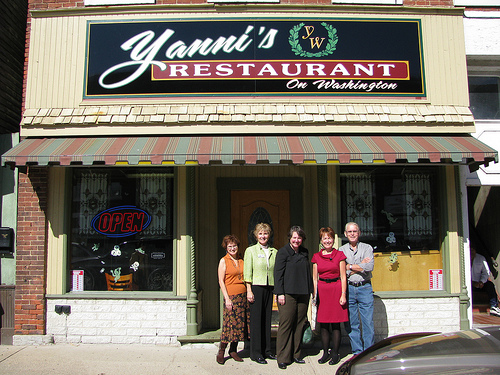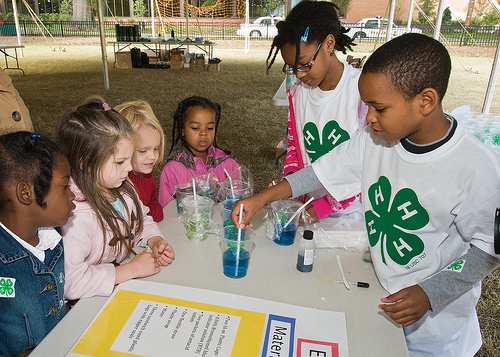
(From left) Dr. Gene Wright, HPWO board chairperson and his wife Jeanne; Randy Runyon, Ohio Association of Community Health Centers President/CEO; Tony Logan, Ohio Rural Development State Director; Patricia Morones, Golden Acres Ministrant Center; Phillip Morones, Golden Acres Ministrant Center; Richard Zsambok, Mayor New Carlisle City Council; Janis Sunderhaus, HPWO CEO; and (Cutting ribbon) Lorena Royer, New Carlisle Center Director; gather during a ribbon cutting ceremony marking the official opening of the newly renovated health care clinic serving Clark and surrounding counties.
Helping to bring quality health care to Ohio’s rural residents requires more than a passing interest; it demands a commitment that enables an organization to navigate the challenges that come with such a vision. Ohio Rural Development State Director Tony Logan joined the leadership of Health Partners of Western Ohio (HPWO) at a recent ribbon cutting ceremony to officially open their larger, newly renovated health clinic. Read more »

Deputy Secretary Kathleen Merrigan stopped at Yannis Restaurant on her tour of businesses that benefitted from a revolving loan program funded by a USDA grant to renovate their historic buildings. From left, Main Street Momence board member Fran LeBeau, USDA Rural Development State Director Colleen Callahan, Merrigan, Main Street Momence Executive Director Janine Loftus, and building owner John Valaveris.
This week, Agriculture Deputy Secretary Kathleen Merrigan toured the Main Street of Momence, Il, to view the positive growth made possible by USDA’s investments in rural revitalization. The community was decorated with corn stalks and fall mums to welcome Agriculture Deputy Secretary Merrigan to this town of 3,200 people, located 50 miles south of Chicago. Merrigan and Momence residents enthusiastically toured several businesses that received financing thanks to a USDA Rural Business Enterprise Grant (RBEG), administered by the USDA Rural Development agency. Last year USDA provided a $99,000 grant to “Main Street Momence,” a preservation and volunteer based economic development program, to help them establish a revolving, low-interest loan fund. The program is designed to help small businesses locate or remain in Momence’s historic downtown area. Thirteen months later, four businesses have taken advantage of the increased access to credit by taking out loans. As a result, these businesses have created 27 new full time jobs and saved another 21 in this past year alone. Read more »
On October 5, it was my great privilege to kick off Rural Development (RD) and the Foreign Agricultural Service’s (FAS) joint celebration of National Hispanic Heritage Month at USDA’s Jefferson Auditorium. The theme for this month’s celebration is “Heritage, Diversity, Integrity and Honor: The Renewed Hope of America.” Read more »

Earthworms generate tons of casts per acre each year, dramatically altering soil structure. Credit: Clive A. Edwards, The Ohio State University, Columbus. (pulled from the NRCS web site)
Earthworms can generate tons of nutrient rich droppings, or “casts,” per acre each year on agricultural lands and gardens. And they’re such industrious little diggers that they can literally turn over the entire top six inches of a field in as few as 10 years. Read more »

Charles Johnson and Alyssa Campbell fifth grade students demonstrate the effects of carbon dioxide on the atmosphere and what we can do to replace our carbon footprint at Hearst Elementary School in Washington, DC. The experiment was part of the 4-H National Youth Science Day, National Science Experiment, 4-H2O.
I went back to school yesterday. And my teachers were fourth graders.
Fourth grade students at Hearst Elementary School in Washington, DC taught me and 200 other students about climate change, water quality and carbon footprints through the 4-H National Science Experiment. All across the country and world, hundreds of thousands of students were doing the same set of experiments today as part of 4-H National Youth Science Day. We saw how carbon dioxide builds up in the atmosphere and what its effects can be. Watching students make connections between their actions and the environment was really exciting for me, and with a sixth grader of my own, it was fun to experience science with these students and get a glimpse of how empowering science can be for these youngsters. Read more »

Dave Hiatt, NRCS biologist, at one of the Clark County easements that, since stopped being cropped, has begun the process of returning back to a floodplain.
In 2008, Illinois received an unprecedented amount of rainfall, which flooded thousands of acres of agricultural lands. Historically, much of this land was floodplains that held and drained water. But in the past century, over half of the floodplains in Illinois have been altered by levees, lock and dams, and stream channelization. Water that enters these lands not only takes longer to drain, but also causes millions of dollars in crop damage. Read more »





